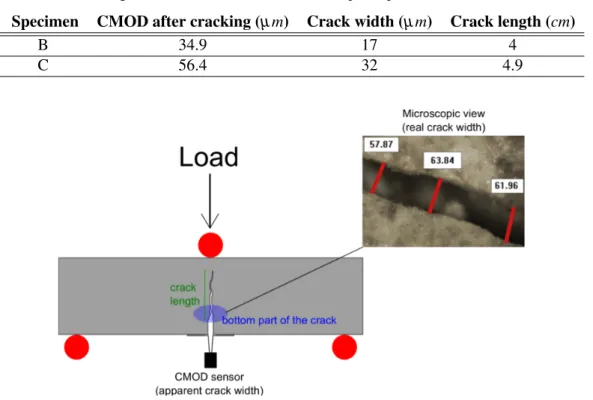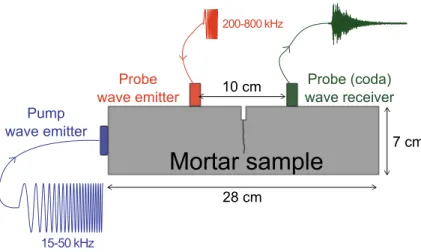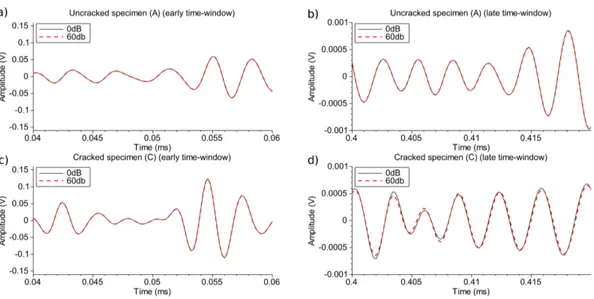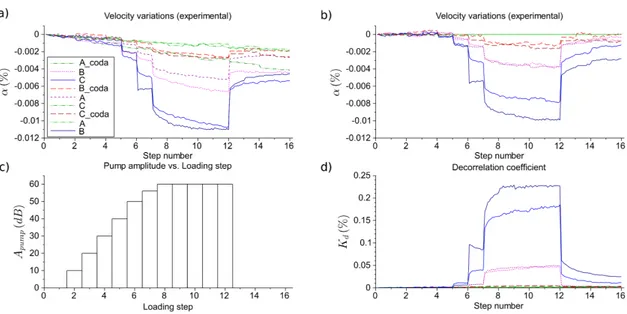HAL Id: hal-01021037
https://hal.inria.fr/hal-01021037
Submitted on 9 Jul 2014HAL is a multi-disciplinary open access archive for the deposit and dissemination of sci-entific research documents, whether they are pub-lished or not. The documents may come from teaching and research institutions in France or abroad, or from public or private research centers.
L’archive ouverte pluridisciplinaire HAL, est destinée au dépôt et à la diffusion de documents scientifiques de niveau recherche, publiés ou non, émanant des établissements d’enseignement et de recherche français ou étrangers, des laboratoires publics ou privés.
Closed Crack Detection in Concrete with Coda Wave
Non-Linear Modulation
Benoit Hilloulin, Yuxiang Zhang, Odile Abraham, Frédéric Grondin, Ahmed
Loukili, Olivier Durand, Vincent Tournat
To cite this version:
Benoit Hilloulin, Yuxiang Zhang, Odile Abraham, Frédéric Grondin, Ahmed Loukili, et al.. Closed Crack Detection in Concrete with Coda Wave Non-Linear Modulation. EWSHM - 7th European Workshop on Structural Health Monitoring, IFFSTTAR, Inria, Université de Nantes, Jul 2014, Nantes, France. �hal-01021037�
C
LOSED CRACK DETECTION IN CONCRETE WITH CODA WAVENON
-
LINEAR MODULATIONBenoit Hilloulin1, Yuxiang Zhang2,3,4, Odile Abraham2, Fr´ed´eric Grondin1, Ahmed Loukili1, Olivier Durand2, Vincent Tournat3
1LUNAM Universit´e, Ecole Centrale de Nantes, Institut de Recherche en G´enie Civil et M´ecanique
(GeM), UMR-CNRS 6183, 44300 Nantes, France
2LUNAM Universit´e, IFSTTAR, GERS, CS4, F-44344 Bouguenais Cedex, France
3LUNAM Universit´e, LAUM, CNRS UMR 6613, Universit´e du Maine, Av. O. Messiaen, 72085 Le
Mans Cedex 9, France
4ISTerre, Universit´e Joseph Fourier, 1381 rue de la Piscine, 38400 Grenoble, France
benoit.hilloulin@ec-nantes.fr
ABSTRACT
An ultrasonic method, based on nonlinear acoustic mixing of coda waves by lower-frequency swept pump waves, providing for an efficient global detection of small cracks in concrete is presented in this paper. By simultaneous comparison, for uncracked and cracked mortars, of ultrasonic velocity variations and decorrelation coefficient between the unperturbed and the perturbed signals with pump amplitude, the method allows to accurately detect cracks with a width of around 20 µm correlated with velocity variations of approximately 0.01%.
KEYWORDS: Coda Wave Interferometry, Concrete, Cracks, Health monitoring INTRODUCTION
Concrete is very sensitive to crack formation. Cracks are generally taken into consideration into design codes recommendations but they influence the durability of structures. Closed cracks in rein-forced concrete, which are defined as cracks whose lips are in contact, are generally invisible at naked eye (with a width of some dozen of micrometers) and endanger the durability of structures as they ac-celerate the penetration of aggressive substances. In order to optimize structural health management, non-destructive techniques have been extensively studied and, among them, ultrasonic methods offer the advantage to provide information related to the elastic properties including part of the medium which is not directly accessible from its surface. However, up to now, linear ultrasonic methods can only detect large opened cracks [1, 2]. Studies have been recently led to develop nonlinear ultrasonic methods to increase the sensitivity to damage and showed good sensitivity to notches or partially opened cracks [3–6]. However, the detection of small closed cracks in concrete remains a great chal-lenge for NDT techniques. In this study, we present a novel nondestructive technique with the aim to detect closed cracks into concrete.
Coda Wave Interferometry (CWI) which relies on the analysis of the last part of the signal af-ter multiple scataf-tering due to heaf-terogeneities is a very sensitive method. CWI has been successfully adapted to concrete, which is a highly heterogeneous medium, to determine nonlinear elastic proper-ties [7] or detect and locate a small defect (hole of some millimeters) [8]. With the control of the ther-mal bias, CWI can monitor propagation velocities with a high precision (10−5in relative terms) [9].
Besides, acoustic nonlinear modulation amplifies the signature of a defect with the use of an acoustic load provided by a pump source. The sample is submitted to a low amplitude ultrasonic wave (known as probe wave) and a large amplitude wave at a lower frequency (known as pump wave). If the sample contains nonlinearity caused by, e.g. the presence of cracks or, more generally, contact-type
defects, the probe wave will be modulated because of the variation of local and surrounding effective elasticity (elastic modulus or acoustic dissipation) due to the pump excitation [10–14].
In this paper, we present a NDT technique combining the use of diffuse ultrasounds within non-linear modulation method to detect closed cracks in an initially nonnon-linear material (concrete).
1. PHYSICAL BACKGROUND AND METHODOLOGY 1.1 CWI analysis by stretching
Two methods can be applied for the estimation of the variation of velocity: Doublet and Stretching. Under the assumption of a constant variation of velocity, Stretching provides more stable and accurate results [15], hence, an opportunity to increase the sensitivity of detection. For this reason, Stretching has been chosen to carry out the CWI analysis of this study. This method assumes that a decrease (resp increase) in propagation velocity δ vimust be simulated by means of stretching (resp compressing) the
time axis t of a reference signal h0[t] with a given dilatation rate τi= δ vi/v0. In order to quantify the
similarity between the stretched reference signal h0[t(1 + τi)] and the test signal h1[t] within a chosen
time interval [t1,t2], cross-correlation coefficient CC can be calculated according to Equation (1) :
CC(t1,t2) (h0,h1)(τi) = Rt2 t1 h0[t(1 + τi)] . h1[t] dt q Rt2 t1 h 2 0[t(1 + τi)] dt . Rt2 t1 h 2 1[t] dt (1)
Following a grid search to maximize the cross-correlation coefficient as a function of τi, the
relative variation of velocity α = (v1− v0)/v0 = δ v/v0 can be derived, where v1 is the estimated
perturbed propagation velocity. Besides, the cross-correlation coefficient CC(α) and the decorrelation coefficient Kd = 1 - CC(α) (from 0% to 100%) give an indication about the decorrelation between the unperturbed and the perturbed signals.
1.2 Nonlinear mixing via frequency-swept pump waves
In order to minimize this pump frequency dependence on the extracted and Kd, frequency-swept pump waves are used as recommended by [14] instead of searching for close resonance frequencies. With frequency-swept pump waves, several modes of the specimen can be excited. Excitation occurs over a relatively wide band (in our case, 10 - 50 kHz which corresponds to around 20 modes numerically determined and observed experimentally). Hence, one can consider that the samples can be excited homogeneously in space and the results would not be affected by the presences of localized vibration nodes, thereby making it possible to conduct a global inspection. In the following, experiments are carried out to show that this principle can be extended to closed crack detection in mortar.
2. EXPERIMENT DESIGN 2.1 Specimen preparation
Mortar samples with dimensions of 7 cm x 7 cm x 28 cm were prepared with a water to cement ratio of 0.35. Mortar mixtures consisted of 1350 g sand (0/2 sand), 450 g Portland cement (CEM II), 155 g water and 8 g superplasticizer (ChrysoFluid Optima 206). After 1 day curing in sealed conditions in an air-conditioned room with a temperature of 20◦C, the specimens were demoulded and further cured in sealed conditions wrapped in aluminium foil.After 1 week, a notch with a depth of 1.5 cm and a width of 5 mm was created at the centre of the beam in order to initiate the crack. The specimens were placed again in the same curing conditions until the creation of the cracks.
Two weeks after casting, two of the three specimens were cracked using crack mouth opening displacement (CMOD) controlled three-point-bending test. In order to study the influence of the crack width on CWI measurements, specimens B and C were cracked with different CMOD values after EWSHM 2014 - Nantes, France
unloading. CMOD values and crack geometrical details after unloading are summarized in Table 1 and explicated in Figure 1.
Table 1 : Crack geometrical details of the cracked samples (specimen A is left uncracked)
Specimen CMOD after cracking (µm) Crack width (µm) Crack length (cm)
B 34.9 17 4
C 56.4 32 4.9
Figure 1 : Schematic diagram of three-point-bending test and crack geometrical properties measurement.
2.2 CWI set-up
To achieve CWI measurements, three piezoelectric transducers were glued on each specimen: two transducers with a working frequency range between 200 and 800 kHz were glued to the specimen around the notch for the probe wave excitation and detection, and one piezoelectric ceramic generating the larger-amplitude pump acoustic wave at lower frequencies typically in the range of 10 – 50 kHz was glued at a side of each specimen (Figure 2).
The excitation signal for the probe source was a chirp with frequency varying linearly from 200 kHz to 800 kHz. The formation of coda wave is mainly due to the multiply reflected by the boundaries of the specimen. Synchronously, a 4-ms-long received signal is recorded by probe receiver using a 5-MHz sampling frequency and 16-bit amplitude dynamics. In order to improve the signal-to-noise ratio, an average of 256 successive acquisitions is set as one coda record, and 10 successive records are saved.
A pump signal with a lower frequency (10 – 50 kHz) is sent to the specimen to induce nonlinear acoustic modulation. The pump signals fed to transducer are amplified by a Bru¨el & Kjær type-R
2713 power amplifier up to 100 V RMS. During the test, the pump signal amplitude is manually altered through the power amplifier gain. The pump signal is linearly swept in frequency from 10 to 50 kHz in 11 ms, and swept signals are continuously generated. In order to distribute the effect of the swept pump waves on the coda waves, pump and probe signals are generated in an asynchronous manner.
A late time-window between t1 = 0.3 ms and t2 = 0.5 ms is used to performed CWI analysis. To choose such a time-window one needs to ensure: 1) it contains enough signals to performed Stretching
Mortar sample
28 cm 7 cm 10 cm Pump wave emitter Probe wave emitter Probe (coda) wave receiver 200-800 kHz 15-50 kHzFigure 2 : Schematic diagram of three-point-bending test and crack geometrical properties measurement.
calculation reliably and 2) these signals should be formed by waves that underwent a sufficient number of scattering events. Figure 3 represents one recorded signal with the time-window used for the CWI analysis.
Figure 3 : Temporal coda signals recorded and time-window used for CWI analysis.
3. EXPERIMENTAL RESULTS AND DISCUSSION
With the pump wave amplitude increased from 0 to 60 dB, signals recorded from an uncracked speci-men are almost identical (Figure 4 a-b), while those from cracked specispeci-mens show a small phase shift and waveform distortion, which is only visible in a late time-window (Figure 4 c-d). Thus, this finding indicates that nonlinear modulation has taken place due to the presence of a crack in the specimen and emphasizes the benefit of analysing the coda part of the signals.
The velocity variations induced by the pump excitation output from CWI measurements allow the detection of a crack. Indeed, for the cracked specimens, when the pump amplitude is increased from 0 dB to 60 dB, the propagation velocity decreases by up to 0.025% as illustrated in Figure 5 while a smaller velocity variation can be observed on uncracked specimens when the pump amplitude is increased.
EWSHM 2014 - Nantes, France
Figure 4 : Temporal coda signals recorded and time-window used for CWI analysis: a), b) an uncracked spec-imen (A), c) and d) for a cracked specspec-imen (C) with two different pump wave amplitudes Apump (0 dB and 60 dB). a) and c) are close-ups of the coda signals during an early time interval (20-s wide); and b) and d) are close-ups of the coda signals during a late time interval (20-s).
A thermal bias correction as depicted in Figure 5 b) is implemented numerically by subtracting the results for alpha of the specimen which was not excited by its pump emitter to the two other samples. Thus, a clear distinction can thus be made between cracked and uncracked specimens when the pump amplitude exceeds 50 dB. The wave-form of the cracked specimen is changed when the pump amplitude increases as illustrated by the variation of the decorrelation coefficient Kd. CWI analysis results also allow to discriminate the specimen C with the larger crack from the specimen B with a smaller crack. When the pump amplitude is decreased back to 0 dB after an excitation to 60 dB, both α and Kd return to values very close to the initial values obtained at the beginning of the test. A linear fit for the evolution of corrected propagation velocity as a function of pump amplitude agrees well with the CWI data (Figure 6) as proposed by [14]. This linear fit allows a clear distinction between cracked and uncracked specimen. For the decorrelation coefficient Kd, a quadratic increase with pump amplitude is found.
CONCLUSION
In this study, an implementation of a novel NDT method combining the use of Coda Wave Interfer-ometry (CWI) with a nonlinear acoustic modulation process has been proposed following the original method developed by [14]. This method shows the capabilities of global detection of very small de-fects in concrete using coda signals that potentially originate from multiple scattering or reverberating media. The main idea is to utilize wide-frequency band signals, for both the probing coda signals (200 – 800 kHz frequency sweeps) and pump wave (10 – 50 kHz frequency sweeps), which acts to modulate the medium properties encountered by the probe (coda) wave. Originally developed to detect large nonlinear defects in a linear medium, the method can be successfully applied to detect small and nonlinear defects as cracks in an otherwise nonlinear medium such as concrete and mortar. The pump wave amplitude influences the detected coda signal and the method observables show good sensitivity to the presence of defects. The changes in velocity variations and decorrelation coefficient vs pump amplitude allow to discriminate cracked mortar from uncracked mortar. The method is reproducible and can provide an easy way to differentiate damaged and sound concrete. Several applications of this technique could be developed in the field of civil engineering. For example, the detection of small
Figure 5 : Results of CWI analysis of probe coda waves mixed with pump waves for the first series: a) Velocity variation a vs. step number; b) Corrected velocity variation vs step; c) Excitation amplitude of the pump waves at each step of the test; and d) Decorrelation coefficient a vs. step number. Specimen name with ’coda’ indicates a specimen which is not excited by the pump waves and which is used for temperature compensation of the following two specimens in the legend. Thus, the three groups of three specimens of the legend correspond to three experiments for three activated pump configurations.
Figure 6 : Pump amplitude dependence of CWI measurements: a) Corrected velocity variation α vs. normalized pump amplitude and b) Remnant correlation coefficient Kd vs. normalized pump amplitude. Both the linear and quadratic fits are proposed. Standard deviations are indicated.
EWSHM 2014 - Nantes, France
cracks causing leakage could be realised without the need of percolating fluid. Moreover, it could be possible that a mechanical information about microscopic damage could be obtained from this very sensitive method.
ACKNOWLEDGEMENTS
Financial support from the GIS LIRGeC, Rgion Pays de la Loire (France), for this study is gratefully acknowledged.
REFERENCES
[1] G. H´evin, O. Abraham, H.A. Pedersen, and M. Campillo. Characterization of surface cracks with rayleigh waves: a numerical model. NDT & E International, 31(4):289 – 297, 1998.
[2] Seong-Hoon Kee and Jinying Zhu. Surface wave transmission measurements across distributed surface-breaking cracks using air-coupled sensors. Journal of Sound and Vibration, 330(22):5333 – 5344, 2011. [3] Peter B. Nagy. Fatigue damage assessment by nonlinear ultrasonic materials characterization.
Ultrason-ics, 36:375–381, 1998.
[4] SathishK. Ramamoorthy, Yogesh Kane, and JosephA. Turner. Ultrasound diffusion for crack depth determination in concrete. In W. Arnold and S. Hirsekorn, editors, Acoustical Imaging, volume 27 of Acoustical Imaging, pages 121–128. Springer Netherlands, 2004.
[5] Frederik Deroo, Laurence J. Jacobs, Jin Yeon Kim, Jianmin Qu, and Karim Sabra. Damage detection in concrete using diffuse ultrasound measurements. AIP Conference Proceedings, 1211(1):1509–1516, 2010.
[6] A. Quiviger, C. Payan, J.-F. Chaix, V. Garnier, and J. Salin. Effect of the presence and size of a real macro-crack on diffuse ultrasound in concrete. NDT & E International, 45(1):128 – 132, 2012.
[7] C. Payan, V. Garnier, J. Moysan, and P. A. Johnson. Determination of third order elastic constants in a complex solid applying coda wave interferometry. Applied Physics Letters, 94(1):–, 2009.
[8] Dennis P. Schurr, Jin-Yeon Kim, Karim G. Sabra, and Laurence J. Jacobs. Damage detection in concrete using coda wave interferometry. NDT & E International, 44(8):728 – 735, 2011.
[9] Yuxiang Zhang, Odile Abraham, Vincent Tournat, Alain Le Duff, Bertrand Lascoup, Ahmed Loukili, Fr´ed´eric Grondin, and Olivier Durand. Validation of a thermal bias control technique for coda wave interferometry (cwi). Ultrasonics, 53(3):658 – 664, 2013.
[10] D. Donskoy, A. Sutin, and A. Ekimov. Nonlinear acoustic interaction on contact interfaces and its use for nondestructive testing. NDT & E International, 34(4):231 – 238, 2001.
[11] Vladimir Zaitsev, Veniamin Nazarov, Vitaly Gusev, and Bernard Castagnede. Novel nonlinear-modulation acoustic technique for crack detection. NDT & E International, 39(3):184 – 194, 2006. [12] V.Yu. Zaitsev, L.A. Matveev, and A.L. Matveyev. On the ultimate sensitivity of nonlinear-modulation
method of crack detection. NDT & E International, 42(7):622 – 629, 2009.
[13] V.Yu. Zaitsev, L.A. Matveev, and A.L. Matveyev. Elastic-wave modulation approach to crack detection: Comparison of conventional modulation and higher-order interactions. NDT & E International, 44(1):21 – 31, 2011.
[14] Y. Zhang, V. Tournat, O. Abraham, O. Durand, S. Letourneur, A. Le Duff, and B. Lascoup. Nonlin-ear mixing of ultrasonic coda waves with lower frequency-swept pump waves for a global detection of defects in multiple scattering media. Journal of Applied Physics, 113(6), 2013.
[15] C´eline Hadziioannou, Eric Larose, Olivier Coutant, Philippe Roux, and Michel Campillo. Stability of monitoring weak changes in multiply scattering media with ambient noise correlation: Laboratory experiments. The Journal of the Acoustical Society of America, 125:3688–3695, 2009.



